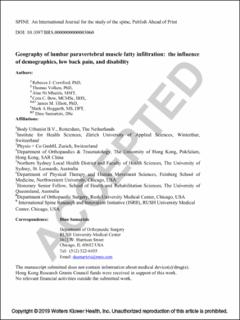Please use this identifier to cite or link to this item:
https://doi.org/10.21256/zhaw-3231Full metadata record
| DC Field | Value | Language |
|---|---|---|
| dc.contributor.author | Crawford, Rebecca J. | - |
| dc.contributor.author | Volken, Thomas | - |
| dc.contributor.author | Mhuiris, Áine Ni | - |
| dc.contributor.author | Bow, Cora C. | - |
| dc.contributor.author | Elliott, James M. | - |
| dc.contributor.author | Hoggarth, Mark A | - |
| dc.contributor.author | Samartzis, Dino | - |
| dc.date.accessioned | 2019-06-05T12:33:40Z | - |
| dc.date.available | 2019-06-05T12:33:40Z | - |
| dc.date.issued | 2019 | - |
| dc.identifier.issn | 0362-2436 | de_CH |
| dc.identifier.issn | 1528-1159 | de_CH |
| dc.identifier.uri | https://digitalcollection.zhaw.ch/handle/11475/17230 | - |
| dc.description.abstract | Study Design: Cross-sectional Objective: We quantified fatty infiltration (FI) geography of the lumbar spine to identify whether demographics, temporal low back pain (LBP), and disability influence FI patterns. Summary of Background Data: Lumbar paravertebral muscle FI has been associated with age, sex, LBP, and disability; yet, FI accumulation patterns are inadequately described to optimise interventions. Methods: This cross-sectional study employed lumbar axial T1-weighted MRI in 107 Southern-Chinese adults (54 females, 53 males). Single-slices at the vertebral inferior end-plate per lumbar level were measured for quartiled-FI, and analysed against demographics, LBP, and disability (ODI: Oswestry Disability Index). Results: Mean FI% was higher in females, on the right, increased per level caudally, and from medial to lateral in men (p < 0.05). FI linearly increased with age for both sexes (p < 0.01) and was notably higher at L4&5 than L1,2&3 for cases aged 40-65yrs. BMI and FI were unrelated in females and inversely in males (p < 0.001). Females with LBPweek and males with LBPyear had 1.7% (each) less average FI (p < 0.05) than those without pain at that time-point. Men locating their LBP in the back had less FI than those without pain (p < 0.001). Disability was unrelated to FI for both sexes (p > 0.05). Conclusions: Lumbar paravertebral muscle FI predominates in the lower lumbar spine, notably for those aged 40-65, and depends more on sagittal than transverse distribution. Higher FI in females and differences of mean FI between sexes for BMI, LBP, and disabling ODI suggest sex-differential accumulation patterns. Our study contradicts pain models rationalising lumbar muscle FI and may reflect a normative sex-dependent feature of the natural history of lumbar paravertebral muscles. | de_CH |
| dc.language.iso | en | de_CH |
| dc.publisher | Lippincott Williams & Wilkins | de_CH |
| dc.relation.ispartof | Spine | de_CH |
| dc.rights | https://creativecommons.org/licenses/by-nc-nd/4.0/ | de_CH |
| dc.subject | Paravertebral | de_CH |
| dc.subject | Muscle | de_CH |
| dc.subject | Multifidus | de_CH |
| dc.subject | Low back pain | de_CH |
| dc.subject | Disability | de_CH |
| dc.subject | Disc degeneration | de_CH |
| dc.subject | Phenotype | de_CH |
| dc.subject | Fatty infiltration | de_CH |
| dc.subject.ddc | 616.7: Krankheiten des Bewegungsapparates und Orthopädie | de_CH |
| dc.title | Geography of lumbar paravertebral muscle fatty infiltration | de_CH |
| dc.type | Beitrag in wissenschaftlicher Zeitschrift | de_CH |
| dcterms.type | Text | de_CH |
| zhaw.departement | Gesundheit | de_CH |
| zhaw.organisationalunit | Institut für Public Health (IPH) | de_CH |
| dc.identifier.doi | 10.1097/BRS.0000000000003060 | de_CH |
| dc.identifier.doi | 10.21256/zhaw-3231 | - |
| dc.identifier.pmid | 30946297 | de_CH |
| zhaw.funding.eu | No | de_CH |
| zhaw.originated.zhaw | Yes | de_CH |
| zhaw.publication.status | acceptedVersion | de_CH |
| zhaw.embargo.end | 2020-07-01 | de_CH |
| zhaw.publication.review | Peer review (Publikation) | de_CH |
| Appears in collections: | Publikationen Gesundheit | |
Files in This Item:
| File | Description | Size | Format | |
|---|---|---|---|---|
| geography_of_lumbar_paravertebtral_muscle_fatty_infiltration.pdf | Accepted Version | 570.12 kB | Adobe PDF |  View/Open |
Show simple item record
Crawford, R. J., Volken, T., Mhuiris, Á. N., Bow, C. C., Elliott, J. M., Hoggarth, M. A., & Samartzis, D. (2019). Geography of lumbar paravertebral muscle fatty infiltration. Spine. https://doi.org/10.1097/BRS.0000000000003060
Crawford, R.J. et al. (2019) ‘Geography of lumbar paravertebral muscle fatty infiltration’, Spine [Preprint]. Available at: https://doi.org/10.1097/BRS.0000000000003060.
R. J. Crawford et al., “Geography of lumbar paravertebral muscle fatty infiltration,” Spine, 2019, doi: 10.1097/BRS.0000000000003060.
CRAWFORD, Rebecca J., Thomas VOLKEN, Áine Ni MHUIRIS, Cora C. BOW, James M. ELLIOTT, Mark A HOGGARTH und Dino SAMARTZIS, 2019. Geography of lumbar paravertebral muscle fatty infiltration. Spine. 2019. DOI 10.1097/BRS.0000000000003060
Crawford, Rebecca J., Thomas Volken, Áine Ni Mhuiris, Cora C. Bow, James M. Elliott, Mark A Hoggarth, and Dino Samartzis. 2019. “Geography of Lumbar Paravertebral Muscle Fatty Infiltration.” Spine. https://doi.org/10.1097/BRS.0000000000003060.
Crawford, Rebecca J., et al. “Geography of Lumbar Paravertebral Muscle Fatty Infiltration.” Spine, 2019, https://doi.org/10.1097/BRS.0000000000003060.
Items in DSpace are protected by copyright, with all rights reserved, unless otherwise indicated.